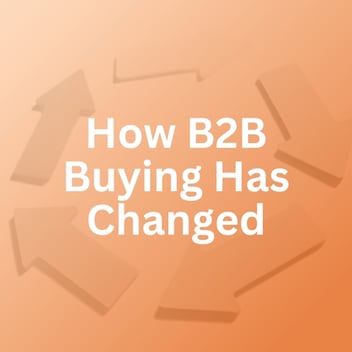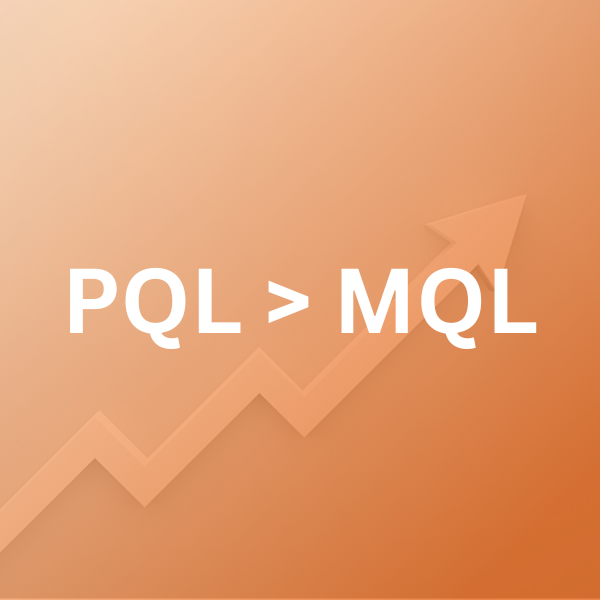
4 Ways B2B Buying Has Changed - And How Sales Must Adapt
4 Ways B2B Buying Has Changed – And How Sales Teams Must Adapt
According to a recent index of...
In today's dynamic business landscape, the rules of engagement have drastically changed. Buyers are no longer satisfied with mere promises; they demand value upfront. The era of Product-Led Growth (PLG) is upon us and has reshaped the way businesses approach sales and customer acquisition. This paradigm shift emphasizes the importance of letting the product shine, rather than locking insights into how it works behind sales conversations.
In this blog, we'll focus specifically on why businesses should ditch the traditional strategy of driving Marketing Qualified Leads (MQLs) and instead, capture Product Qualified Leads (PQLs) to improve their go-to-market efficiency.
At its core, a PQL represents a potential customer who has taken meaningful interaction with your product. That engagement can take many forms, including (but not limited to) using a free trial of your product, interacting with certain features, exploring an interactive demonstration, and even watching videos of your product in action.
So why does generating PQLs outweigh the traditional approach of capturing MQLs? Below are five major reasons, all culminating to improve your go-to-market efficiency and improving sales effectiveness.
The majority of MQLs are not representative of individuals ready to buy. MQLs are typically generated through engagement with content or filling out a form – actions that can be taken for a variety of reasons that don’t indicate real intent to become a user. Passing leads on to your sales team that are merely conducting research or are out of your target market sets your Sales team up for failure from the jump.
PQLs, however, are typically further along the decision making process than a traditional MQL because they’ve had firsthand experience with your product. In addition, their interaction is an indicator that they’re likely a fit as a potential customer. Generating PQLs allows your Sales team to focus its resources on leads that have demonstrated real potential to become buyers.
Sales teams can analyze a PQL’s engagement data to know what parts of the product are of interest to the lead, helping to improve their sales effectiveness and efficiency. This is especially helpful for businesses selling a broad product offering. An MQL, on the other hand, hasn’t engaged with your product, leaving PreSales and Sales teams “in the dark” about what that MQL is interested in and making it difficult to prove value.
Because PQLs have had meaningful engagement with your product, they’re much more educated about how it works when it’s time to engage with Sales. Instead of conducting conversations consisting of educating leads about your product (as is often the case with MQLs) Sales teams can dive much deeper into the problems prospects are looking to solve, giving them a better chance to build value and create a consultative relationship with buyers.
Here’s an example of how MercuryGate improved its conversion rate by creating more educated leads at the top of the funnel.
Buyers today don’t want to leave their personal information in a form to get a glimpse into the product. Nor do they want to wait days or sometimes weeks to see your product in action. With buyers now expecting on demand, ungated product experiences, asking buyers to fill out forms builds skepticism and simply drives them to competitors.
Instead, modern businesses are thriving by offering transparent self-service models that allow buyers to get acquainted with your product. Whether it's a freemium offering or a comprehensive product experience, enabling users to explore the product independently is crucial to building trust with your buyers – a component we all know is vital to winning deals.
Capturing PQLs allows companies to optimize their Go-To-Market (GTM) strategies. By seeing which parts of the product users engage with most and analyzing the ensuing conversion rates, GTM teams can know which offerings to double-down on and identify points of improvement for increased conversion.
In addition, looking at the engagement data gives Sales teams a clear picture if someone is truly interested in your offering or not, and if it’s worth the time and effort to pursue them. With MQLs, however, it’s challenging for both the lead AND the Sales team to gauge if there’s a good fit, and often leads to wasted time and resources.
As OpenView reports, the most useful predictor of growth is if a business is tracking product qualified leads or product qualified accounts (PQAs) in their CRM. And it’s clear to see why – capturing PQLs gives sales teams a much higher chance of success while helping marketing teams optimize their strategies.
There are many ways that you can capture PQLs for your business, including freemium offers, free trials, interactive demos, and more. Choosing the right one largely depends on the nature of your product and your target market.
An option that many leading revenue teams are succeeding with today is by placing searchable, interactive demos of their products on their websites to give each visitor an on-demand product experience.
Read what Omedym customers have to say about their experiences with the platform on G2.

According to a recent index of...

Interactions with buyers are essential to moving deals down the sales cycle. Unfortunately, buyers...

Imagine that you’ve been tasked with finding a software solution for your business. What would your...
